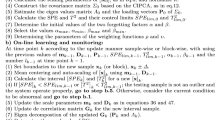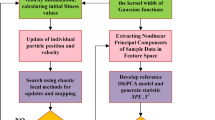Abstract
In recent years, fault detection and diagnosis for industrial processes have been rapidly developed to minimize costs and maximize efficiency by taking advantages of cheap sensors and microprocessors, data analysis and artificial intelligence methods. However, due to the nonlinear and dynamic characteristics of industrial process data, the accuracy and efficiency of fault detection and diagnosis methods have always been an urgent problem in industry and academia. Therefore, this study proposes an adaptive fault detection and root-cause analysis scheme for complex industrial processes using moving window kernel principle component analysis (KPCA) and information geometric causal inference (IGCI). The proposed scheme has three main contributions. Firstly, a research scheme combining moving window KPCA with adaptive threshold is presented to handle the nonlinear and dynamic characteristics of complex industrial processes. Then, the multiobjective evolutionary algorithm is employed to select the optimal hyperparameters for fault detection, which not only avoids the blindness of hyperparameters selection, but also maximize model accuracy. Finally, the IGCI-based fault root-cause analysis method can help field operators to take corrective measures in time to resume the normal process. The proposed scheme is tested by the Tennessee Eastman platform. Its results show that this scheme has a good performance in reducing the faulty false alarms and missed detection rates and locating fault root-cause.









Similar content being viewed by others
References
Alvarado-Iniesta, A., Guillen-Anaya, L. G., Rodríguez-Picón, L. A., & Ñeco-Caberta, R. (2020). Multi-objective optimization of an engine mount design by means of memetic genetic programming and a local exploration approach. Journal of Intelligent Manufacturing, 31(1), 19–32.
Bakdi, A., & Kouadri, A. (2017). A new adaptive PCA based thresholding scheme for fault detection in complex systems. Chemometrics and Intelligent Laboratory Systems, 162, 83–93.
Barzel, B., & Barabási, A. L. (2013). Network link prediction by global silencing of indirect correlations. Nature biotechnology, 31(8), 720–725.
Censor, Y. (1977). Pareto optimality in multiobjective problems. Applied Mathematics and Optimization, 4(1), 41–59.
Chen, H., Jiang, B., Lu, N., & Mao, Z. (2018). Deep PCA based real-time incipient fault detection and diagnosis methodology for electrical drive in high-speed trains. IEEE Transactions on Vehicular Technology, 67(6), 4819–4830.
Da Cunha, N. O., & Polak, E. (1967). Constrained minimization under vector-valued criteria in finite dimensional spaces. Journal of Mathematical Analysis and Applications, 19(1), 103–124.
Daniusis, P., Janzing, D., Mooij, J., Zscheischler, J., Steudel, B., Zhang, K., & Schölkopf, B. (2012). Inferring deterministic causal relations. ar**v preprint ar**v:1203.3475.
Dong, J., Wang, M., Zhang, X., Ma, L., & Peng, K. (2017). Joint data-driven fault diagnosis integrating causality graph with statistical process monitoring for complex industrial processes. IEEE Access, 5, 25217–25225.
Dong, Y., & Qin, S. J. (2018). A novel dynamic PCA algorithm for dynamic data modeling and process monitoring. Journal of Process Control, 67, 1–11.
Downs, J. J., & Vogel, E. F. (1993). A plant-wide industrial process control problem. Computers & Chemical Engineering, 17(3), 245–255.
Feizi, S., Marbach, D., Médard, M., & Kellis, M. (2013). Network deconvolution as a general method to distinguish direct dependencies in networks. Nature Biotechnology, 31(8), 726.
Gajjar, S., & Palazoglu, A. (2016). A data-driven multidimensional visualization technique for process fault detection and diagnosis. Chemometrics and Intelligent Laboratory Systems, 154, 122–136.
Gonzalez, R., Huang, B., & Lau, E. (2015). Process monitoring using kernel density estimation and Bayesian networking with an industrial case study. ISA Transactions, 58, 330–347.
Hamadouche, A. (2020). Model-free direct fault detection and classification. Journal of Process Control, 87, 130–137.
Heo, S., & Lee, J. H. (2018). Fault detection and classification using artificial neural networks. IFAC-PapersOnLine, 51(18), 470–475.
Hsu, C. W., Chang, C. C., & Lin, C. J. (2013). A practical guide to support vector classification (pp. 1–16). https://www.csie.ntu.edu.tw/~cjlin/papers/guide/guide.pdf.
Huang, J., & Yan, X. (2015). Dynamic process fault detection and diagnosis based on dynamic principal component analysis, dynamic independent component analysis and Bayesian inference. Chemometrics and Intelligent Laboratory Systems, 148, 115–127.
Huang, J., & Yan, X. (2017). Quality relevant and independent two block monitoring based on mutual information and KPCA. IEEE Transactions on Industrial Electronics, 64(8), 6518–6527.
Kouadri, A., Hajji, M., Harkat, M. F., Abodayeh, K., Mansouri, M., Nounou, H., & Nounou, M. (2020). Hidden Markov model based principal component analysis for intelligent fault diagnosis of wind energy converter systems. Renewable Energy, 150, 598–606.
Kusiak, A. (2017). Smart manufacturing must embrace big data. Nature, 544(7648), 23–25.
Kusiak, A. (2018). Smart manufacturing. International Journal of Production Research, 56(1–2), 508–517.
Lahdhiri, H., Elaissi, I., Taouali, O., Harakat, M. F., & Messaoud, H. (2018). Nonlinear process monitoring based on new reduced Rank-KPCA method. Stochastic Environmental Research and Risk Assessment, 32(6), 1833–1848.
Lahdhiri, H., Taouali, O., Elaissi, I., Jaffel, I., Harakat, M. F., & Messaoud, H. (2017). A new fault detection index based on Mahalanobis distance and kernel method. The International Journal of Advanced Manufacturing Technology, 91(5–8), 2799–2809.
Lee, S., & Kim, S. B. (2018). Time-adaptive support vector data description for nonstationary process monitoring. Engineering Applications of Artificial Intelligence, 68, 18–31.
Lee, W. J., Mendis, G. P., Triebe, M. J., & Sutherland, J. W. (2020). Monitoring of a machining process using kernel principal component analysis and kernel density estimation. Journal of Intelligent Manufacturing, 31(5), 1175–1189.
Li, W., & Zhao, C. (2019). Hybrid fault characteristics decomposition based probabilistic distributed fault diagnosis for large-scale industrial processes. Control Engineering Practice, 84, 377–388.
Lu, C. J. (2012). An independent component analysis-based disturbance separation scheme for statistical process monitoring. Journal of Intelligent Manufacturing, 23(3), 561–573.
Ma, L., Dong, J., & Peng, K. (2018a). Root cause diagnosis of quality-related faults in industrial multimode processes using robust Gaussian mixture model and transfer entropy. Neurocomputing, 285, 60–73.
Ma, L., Dong, J., & Peng, K. (2018b). A practical propagation path identification scheme for quality-related faults based on nonlinear dynamic latent variable model and partitioned Bayesian network. Journal of the Franklin Institute, 355(15), 7570–7594.
Ma, L., Dong, J., & Peng, K. (2020). A novel key performance indicator oriented hierarchical monitoring and propagation path identification framework for complex industrial processes. ISA Transactions, 96, 1–13.
Ma, L., Dong, J., Peng, K., & Zhang, C. (2018c). Hierarchical monitoring and root-cause diagnosis framework for key performance indicator-related multiple faults in process industries. IEEE Transactions on Industrial Informatics, 15(4), 2091–2100.
Ma, L., Dong, J., Peng, K., & Zhang, K. (2017). A novel data-based quality-related fault diagnosis scheme for fault detection and root cause diagnosis with application to hot strip mill process. Control Engineering Practice, 67, 43–51.
Mansouri, M., Nounou, M., Nounou, H., & Karim, N. (2016). Kernel PCA-based GLRT for nonlinear fault detection of chemical processes. Journal of Loss Prevention in the Process Industries, 40, 334–347.
Mujica, L. E., Rodellar, J., Fernandez, A., & Güemes, A. (2011). Q-statistic and T2-statistic PCA-based measures for damage assessment in structures. Structural Health Monitoring, 10(5), 539–553.
Navi, M., Meskin, N., & Davoodi, M. (2018). Sensor fault detection and isolation of an industrial gas turbine using partial adaptive KPCA. Journal of Process Control, 64, 37–48.
Reshef, D. N., Reshef, Y. A., Finucane, H. K., Grossman, S. R., McVean, G., Turnbaugh, P. J., Lander, E. S., Mitzenmacher, M., & Sabeti, P. C. (2011). Detecting novel associations in large data sets. Science, 334(6062), 1518–1524.
Said, M., ben Abdellafou, K., & Taouali, O. (2019). Machine learning technique for data-driven fault detection of nonlinear processes. Journal of Intelligent Manufacturing, 334, 1–20.
Sbalzarini, I. F., Müller, S., & Koumoutsakos, P. (2000). Multiobjective optimization using evolutionary algorithms. In Proceedings of the summer program (Vol. 2000, pp 63–74).
Simani, S., & Castaldi, P. (2019). Intelligent fault diagnosis techniques applied to an offshore wind turbine system. Applied Sciences, 9(4), 783.
Simani, S., Farsoni, S., & Castaldi, P. (2018). Data-driven techniques for the fault diagnosis of a wind turbine benchmark. International Journal of Applied Mathematics and Computer Science, 28(2), 247–268.
Skordilis, E., & Moghaddass, R. (2017). A condition monitoring approach for real-time monitoring of degrading systems using Kalman filter and logistic regression. International Journal of Production Research, 55(19), 5579–5596.
Sun, Y. N., Qin, W., & Zhuang, Z. L. (2020). Quality consistency analysis for complex assembly process based on Bayesian networks. Procedia Manufacturing, 51, 577–583.
Wang, G., Zhang, Y., Liu, C., **e, Q., & Xu, Y. (2019). A new tool wear monitoring method based on multi-scale PCA. Journal of Intelligent Manufacturing, 30(1), 113–122.
Wang, S., Zhao, Y., Shu, Y., Yuan, H., Geng, J., & Wang, S. (2018). Fast search local extremum for maximal information coefficient (MIC). Journal of Computational and Applied Mathematics, 327, 372–387.
Xu, Y., & Deng, X. (2016). Fault detection of multimode non-Gaussian dynamic process using dynamic Bayesian independent component analysis. Neurocomputing, 200, 70–79.
Zadeh, L. (1963). Optimality and non-scalar-valued performance criteria. IEEE Transactions on Automatic Control, 8(1), 59–60.
Zhang, Y., Zhang, W., & **e, Y. (2013). Improved heuristic equivalent search algorithm based on maximal information coefficient for Bayesian network structure learning. Neurocomputing, 117, 186–195.
Zhou, C., Ding, L. Y., Skibniewski, M. J., Luo, H., & Zhang, H. T. (2018). Data based complex network modeling and analysis of shield tunneling performance in metro construction. Advanced Engineering Informatics, 38, 168–186.
Zhou, F., Park, J. H., & Liu, Y. (2016). Differential feature based hierarchical PCA fault detection method for dynamic fault. Neurocomputing, 202, 27–35.
Zhou, P., Zhang, R., Liang, M., Fu, J., Wang, H., & Chai, T. (2020). Fault identification for quality monitoring of molten iron in blast furnace ironmaking based on KPLS with improved contribution rate. Control Engineering Practice, 97, 104354.
Acknowledgements
The authors would like to acknowledge financial supports of the National Natural Science Foundation of China (Nos. 51775348, U1637211).
Author information
Authors and Affiliations
Corresponding author
Additional information
Publisher's Note
Springer Nature remains neutral with regard to jurisdictional claims in published maps and institutional affiliations.
Rights and permissions
About this article
Cite this article
Sun, Y., Qin, W., Zhuang, Z. et al. An adaptive fault detection and root-cause analysis scheme for complex industrial processes using moving window KPCA and information geometric causal inference. J Intell Manuf 32, 2007–2021 (2021). https://doi.org/10.1007/s10845-021-01752-9
Received:
Accepted:
Published:
Issue Date:
DOI: https://doi.org/10.1007/s10845-021-01752-9




